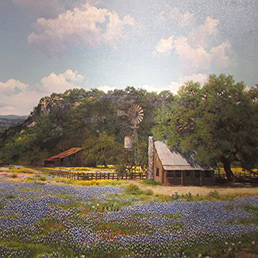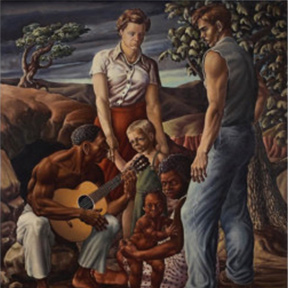- (214) 720-4044
- info@daviddike.com
- Mon - Fri: 10 am - 5 pm
Lea, Tom
Tom Lea
(1907-2001)
Lea was born and reared in El Paso. As a youngster, he worked summers on ranches in Culberson County as well as in Grant and Lincoln counties, New Mexico. In 1924, at age seventeen, he enrolled in the Art Institute of Chicago where he studied three months under John Warner Norton, a noted muralist, before leaving to execute a mural commission. Lea returned to Chicago in 1927 and obtained a position as Norton’s studio assistant. This engagement and Lea’s work as a commercial artist, teacher, and muralist enabled him to save enough money to travel and study in Italy.
On returning to the United States, Lea settled in 1933 in Santa Fe, where he augmented his income by part-time work in the State Laboratory of Anthropology. When his first wife died in 1936, Lea moved to El Paso and opened a downtown studio, working as an illustrator and muralist. In 1940 he completed his mural Stampede, placed in the U.S. Post Office in Odessa and reproduced on the dust jacket of J. Frank Dobie’s The Longhorns (Boston: Little, Brown, 1940).
When World War II began, Life magazine engaged Lea as a combat artist. He recorded numerous actions in Italy, the South Pacific, the China-Burma-India Theater, and the North Atlantic, as well as episodes in the Arctic. After the war, in recognition of his work, he received a Distinguished Service Award from the U.S. Navy. A memorable painting of the period is Lea’s poignant portrayal of a just-wounded young Marine, sketched when Lea landed on Pelelie Island with the assault waves of the First Marine Division, Seventh Regiment, First Battalion. The magazine gave his war paintings to the U.S. Army Center of Military History, Washington, D.C.
Lea returned to El Paso after the war and became a famous muralist, painter, and illustrator. In 1945 Life commissioned Lea to paint a series of canvasses depicting the evolution of the cattle industry. Although they were never published by Life, the magazine gave them to the Dallas Museum of Fine Arts and they have been exhibited occasionally.
In 1935 Lea wrote a published appreciation of Norton’s works and a few other pieces. In 1949 he began what amounted to a concurrent career as a writer of reviews, articles, novels, histories, and biographies, including such well-known works as The Brave Bulls (1949), The Wonderful Country (1952), The King Ranch (1957), and The Hands of Cantu (1964), all published by Little, Brown and Company, Boston. (The Wonderful Country became a film in which Lea was persuaded to play a cameo role as the town barber.) Lea worked closely with Carl Hertzog, El Paso book designer and publisher, and often illustrated his own writings as well as those of others, including Apache Gold and Yaqui Silver, (Boston: Little, Brown, 1936), and The Longhorns (Boston: Little, Brown, 1941), written by his friend J. Frank Dobie. A painting by Lea adorned the dust jacket of Walter Prescott Webb’s The Texas Rangers: A Century of Frontier Defense (Boston: Houghton Mifflin, 1935).
Source: Texas Painters, Sculptors & Graphic Artists by John and Deborah Powers





